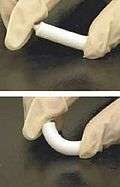Artificial bone

Artificial bone refers to bone-like material created in a laboratory that can be used in bone grafts, to replace human bone that was lost due to severe fractures, disease, etc.[1]
Overview
Bones are rigid organs that serve various functions in the human body (or generally in vertebrates), including mechanical support, protection of soft organs, blood production (from bone marrow), etc. Bone is a very complex tissue: strong, elastic, and self-repairing.[2]
Damaged bone can be replaced with bone from other parts of the body (autografts), from cadavers (allograft), or with various ceramics or metallic alloys. The use of autografts limits how much bone is available.
There has been much research towards creating artificial bone. Richard J. Lagow, at the University of Texas at Austin, developed a way of creating a strong bone-like porous structure from bone powder, which, when introduced in the body, can allow the growth of blood vessels, and which can be gradually replaced by natural bone.[3] Research at the Lawrence Berkeley National Laboratory has resulted in a metal-ceramic composite that has, like bone, a fine microstructure, and which may help create artificial bone.[4] A team of British scientists have developed "injectable bone", a soft substance which hardens in the body. They won the Medical Futures Innovation Award for their discovery, and it is planned to test this material in clinical trials.[5]
Researchers at Columbia University have grown an anatomically correct human jawbone from stem cells, though it was solid bone without the normal accessory tissues such as bone marrow, cartilage, or a connectable blood supply.[6] Other researchers, at the Istec bioceramics laboratory in Italy, have produced a nearly identical substitute for human bone out of rattan wood. The substitute bone has a porous structure permitting blood vessels and other accessory tissues to penetrate it, allowing seamless integration into the host bone. The process has been tested on sheep, who showed no signs of rejection after several months.[7]
References
- ↑ "ARTIFICIAL BONE GRAFTS: PRO OSTEON". Arthroscopy.com. Retrieved 2013-11-16.
- ↑ Angier, Natalie (2009-04-28). "Bone, a Masterpiece of Elastic Strength". The New York Times. Retrieved 2010-04-25.
- ↑ "Artificial bone". Faqs.org. Retrieved 2013-11-16.
- ↑ "Secrets of the Sea Yield Stronger Artificial Bone". Physorg.com. Retrieved 2013-11-16.
- ↑ "Injectable artificial bone developed". Cosmosmagazine.com. Retrieved 2013-11-16.
- ↑ "Jaw bone created from stem cells". BBC News. October 10, 2009. Archived from the original on 11 October 2009. Retrieved 11 October 2009.
- ↑ "Turning wood into bone". BBC News. 8 January 2010. Archived from the original on 9 January 2010. Retrieved 8 January 2010.